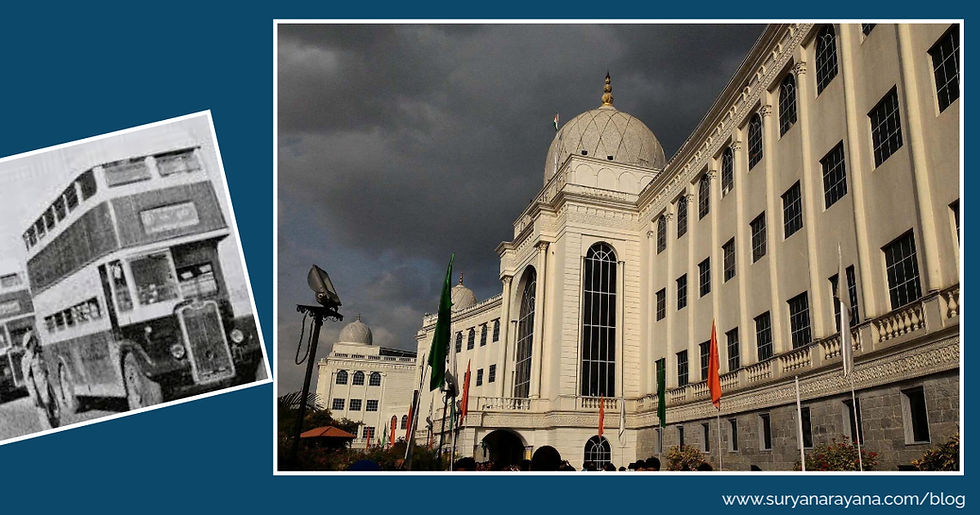MB#25: 𝙈𝙮 𝘿𝙤𝙪𝙗𝙡𝙚-𝘿𝙚𝙘𝙠𝙚𝙧 𝘽𝙪𝙨 𝙍𝙞𝙙𝙚 𝙖𝙣𝙙 𝙃𝙮𝙙𝙚𝙧𝙖𝙗𝙖𝙙 𝙎𝙖𝙡𝙖𝙧 𝙅𝙪𝙣𝙜 𝙈𝙪𝙨𝙚𝙪𝙢 𝙑𝙞𝙨𝙞𝙩.
- www.suryanarayana.com

- 1 day ago
- 3 min read
[MemoirBlogthon #25] In my childhood, my father took me on my first visit to the Salar Jung Museum in Hyderabad. It was a day of profound discovery—from the excitement of riding a double-decker bus to seeing the spectacular Veiled Rebecca statue and waiting for the mesmerizing British musical clock to strike one. That day, my father acted as the perfect guide, initiating a lifelong appreciation for history and culture that I now plan to share with my grandson, comparing the simplicity of 1969 with the museum's modern grandeur.
The British Clock, The Veiled Rebecca, and My First Museum Trip
In 1969, during a summer vacation in Hyderabad, my father gave me my first extraordinary experience of cultural exploration: a visit to the Salar Jung Museum. The adventure began even before we reached the gates, commuting to the old city on a double-decker bus, perched on the top deck and eagerly watching the city unfold.

The historic Salar Jung Museum, situated on the southern bank of the River Musi, was not far from other monuments like the Charminar and Mecca Masjid. I had initially imagined a museum as just a few dusty tables displaying artifacts used by Nawab kings.
As my father pointed out the majestic structure from a distance, I knew there was much more to see. He gave us a concise historical briefing before we bought the entry passes (just ₹10 per head at the time; the crowd was thin). He informed me that the museum had been transferred to its present building just the year before, in 1968, and was now overseen by an Autonomous Board chaired by the Governor.
The Magic of Marguerite and the Musical Clock
As we walked through the halls, my childlike curiosity took over, and I bombarded my father with questions. He was fully prepared, having visited the museum twice when it was in its older location.
He described the masterpieces we were about to see: Aurangzeb's sword, daggers owned by Emperor Shah Jahan and Queen Noor Jahan, and the famous statues, including the Veiled Rebecca.
But the highlight for us, and the target of the largest crowd, was the British-made musical clock (or bracket clock). I asked what made the clock so special. My father explained that it featured a mechanical device that caused a miniature toy figure to emerge from a room, strike a gong at the hour, and then return inside.
We managed to reach the spot ten minutes before 1:00 PM. It was a wonderful spectacle; as it was the middle of the day, the show was extended, with the miniature toy emerging and striking the gong multiple times.
The two items that left the greatest impression on me were the Veiled Rebecca marble statue—a masterpiece where the veil appears transparent—and the impressive collection of arms and armor, including swords made of Damascus steel. My father, reading the artifact descriptions with us, ensured we understood that the Veiled Rebecca was considered one of the museum's most treasured masterpieces.
The Contrast of Then and Now
My day out with my father was my first extraordinary experience of its kind, an educational outing that lasted far longer than the summer vacation. Afterward, I visited the museum with college friends but never spent the whole day dedicated to its contents again.
Decades later, during a foreign trip, an Indian family whose child was raised in Australia told me they had recently visited Salar Jung. They later emailed me with details showing the stark contrast between then and now: the museum now features state-of-the-art facilities, including the Chemical Conservation Laboratory, the Education Wing, and detailed public services like seating, restrooms, and a cafeteria run by the Telangana Tourism department. Furthermore, it now publishes extensive research journals and catalogs for scholars.
This information confirmed a truth: Whether it is a museum or any place of interest, recollecting my earlier visit and experiencing it again after decades helps my age group appreciate the changes.
Now, living in Hyderabad, I desire to take my grandson, Vivaan, for a whole-day visit. I want to share the wonder of the Veiled Rebecca and the British musical clock with him, and for myself, I want to compare my childhood memory with the vast, modern collection. The journey of learning and exploration my father started with me on that double-decker bus is a legacy I am keen to pass on.
MB#25: Quiz
MB25 Question: In 1969, which famous Hyderabad museum was the setting for the author's first trip?
A. The Nizam’s Museum.
B. The Salar Jung Museum.
C. The Birla Science Museum.
D. The AP State Archaeology Museum.
MB#25: Quote










Comments